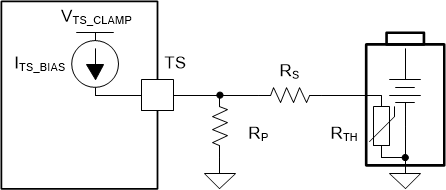SLUSDK0A August 2020 – March 2021 BQ25171-Q1
PRODUCTION DATA
- 1 Features
- 2 Applications
- 3 Description
- 4 Revision History
- 5 Pin Configuration and Functions
- 6 Specifications
- 7 Detailed Description
- 8 Application and Implementation
- 9 Power Supply Recommendations
- 10Layout
- 11Device and Documentation Support
- 12Mechanical, Packaging, and Orderable Information
Package Options
Mechanical Data (Package|Pins)
- DRC|10
Thermal pad, mechanical data (Package|Pins)
- DRC|10
Orderable Information
7.3.2.4 Battery Cold, Hot Temperature Qualification (TS Pin)
While charging, the device continuously monitors battery temperature by sensing the voltage at the TS pin. A negative temperature coefficient (NTC) thermistor should be connected between the TS and GND pins (recommend: 103AT-2). If temperature sensing is not required in the application, connect a fixed 10-kΩ resistor from TS to GND to allow normal operation. Battery charging is allowed when the TS pin voltage falls between VCOLD and VHOT thresholds (typically 0°C – 45°C). The temperature corresponding to these voltage thresholds can be modified by adding resistors in parallel and in series with the thermistor, as shown in Figure 7-6. If the TS pin indicates battery temperature is outside this range, the device stops charging, enters the STANDBY state, and sets the STAT pins to STAT1 = LOW , STAT2 = HIGH to indicate a recoverable fault. Once battery temperature returns to normal conditions, charging resumes automatically.
 Figure 7-6 TS Resistor Network For Modified Temperature
Charging Window
Figure 7-6 TS Resistor Network For Modified Temperature
Charging Window| TEMPERATURE CHARGING WINDOW | RS | RP |
|---|---|---|
| 0°C to 60°C | 1.9 kΩ | 400 kΩ |
| −10°C to 60°C | 2.3 kΩ | 70 kΩ |
| −10°C to 50°C | 1.1 kΩ | 70 kΩ |